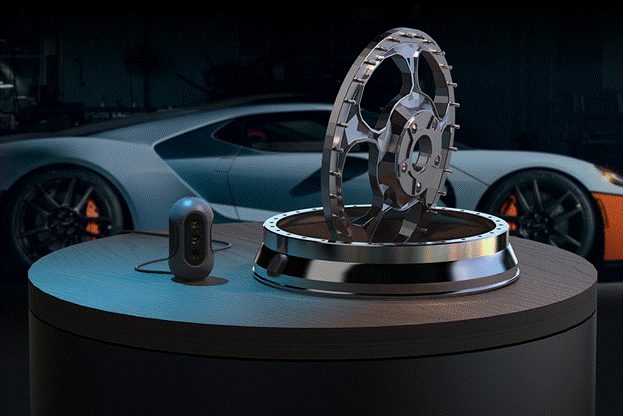
Imagine transforming complex objects into precise digital models in a matter of minutes. That’s exactly what 3D scanning brings to the table, and it’s reshaping how reverse engineering is done. Whether you’re recreating obsolete parts or improving existing designs, this technology offers unmatched accuracy and efficiency.
What Is 3D Scanning Technology?
3D scanning technology captures the physical geometry of an object and transforms it into digital representations. A 3D scanner uses various methods to collect precise data about an item’s shape, size, and structure.
Overview Of 3D Scanning
3D scanning involves non-contact techniques to record detailed surface information. By analyzing coordinates, measurements, and contours, it creates a point cloud—a digital dataset of an object’s physical properties.
These systems are especially useful for documenting intricate designs, curvilinear forms, or irregular shapes that traditional measurement tools struggle to replicate accurately. Handheld and automated models provide flexibility for different use cases.
Manufacturers, archaeologists, and medical professionals often rely on this technology to analyze objects with varying levels of complexity and scale. For instance, scanning human anatomy or industrial equipment benefits significantly from its precision capabilities.
Types Of 3D Scanners
You’ll find various types of 3D scanners based on the technology they employ and their application focus:
- Laser Scanners: Use laser beams to measure distances and angles. Effective for capturing fine details, such as grooves on mechanical parts.
- Structured-Light Scanners: Project light patterns onto a surface and analyze distortions. Ideal for quick and accurate scans of medium-sized objects like sculptures.
- Photogrammetry Systems: Rely on images from different angles to create models. Frequently used in arts, heritage preservation, or when portability is key.
- Contact Probes: Touch the object physically to map surfaces. Useful in precision-demanding tasks like machining or tool calibration.
Understanding these categories ensures you match the technology to your specific project needs. Strategy and context greatly influence the choice of scanner.
Understanding Reverse Engineering
Reverse engineering involves analyzing a physical object to determine its design, composition, or functionality. Employing this process allows you to recreate or enhance an item without needing its original design files.
Definition And Importance
Reverse engineering, at its core, is the process of studying an existing product to understand its construction or operation. This is crucial if detailed documentation or production designs are unavailable. For engineers, this process bridges the gap between existing products and desired modifications.
By employing reverse engineering, you can replicate discontinued parts, analyze competitor products, or improve outdated designs. This technique delivers insight into material composition, manufacturing approaches, and structural properties.
Traditional Methods Vs. 3D Scanning
Traditional reverse engineering methods relied on manual measurements and 2D technical drawings. This process often resulted in errors due to its reliance on physical tools like calipers and rulers. Recreating complex geometries was especially challenging, introducing inaccuracies in the replication phase.
In contrast, 3D scanning improves precision by capturing an object’s entire geometry using digital data. Technologies like laser scanning and structured light deliver high-resolution models, significantly reducing effort.
A comparison between these methods reveals stark differences:
| Aspect | Traditional Methods | 3D Scanning
|
| Accuracy | Prone to manual errors | Extremely high (sub-millimeter) |
| Complexity Handling | Limited to basic shapes | Suitable for intricate geometries |
| Time Required | Weeks or months | Hours or days |
| Documentation Output | 2D drawings | Detailed 3D models |
3D scanning eliminates several inefficiencies tied to traditional practices, transforming how reverse engineering projects progress.
How 3D Scanning Is Revolutionizing Reverse Engineering
3D scanning is significantly altering reverse engineering practices. By introducing advanced capabilities, it’s reshaping how engineers and manufacturers approach design recreation and refinement.
Enhanced Accuracy And Precision
3D scanning captures intricate details of physical objects. High-resolution scanners measure even complex geometries with precision. For example, aerospace engineers often rely on structured-light scanners to recreate turbine blades, ensuring no detail is missed. Reducing errors in these scenarios directly improves product reliability.
Traditional tools like calipers or manual measurements can’t rival this level of detail. The transition to digital models eliminates inconsistencies caused by human error. Measurements become reproducible, which is critical for maintaining consistency in industries like automotive or healthcare.
Speed And Efficiency Improvements
The digitization of objects through 3D scanning significantly reduces time spent on reverse engineering. For instance, a laser scanner can complete detailed scans of a mechanical part in minutes. Conventional methods often take hours or days for comparable results.
This time-saving feature lets you allocate resources more effectively. Manufacturing workflows benefit from faster turnarounds. For example, in product development, scanning prototypes accelerates design validation by quickly providing engineers with accurate models for analysis and redesign.
Cost-Effectiveness
3D scanning can streamline workflows by reducing manual steps and material waste. Streamlining these steps helps reduce manual errors and repetitive rework. Accuracy prevents material waste in part production, improving overall resource use.
Industries like consumer electronics frequently implement 3D scanning to reduce project budgets when updating product designs or repairing existing hardware.
Versatility Across Industries
Different sectors integrate 3D scanning tools for a variety of applications. Archaeologists document cultural artifacts with photogrammetry systems, maintaining digital archives of fragile items. Medical professionals, on the other hand, use these devices to create custom prosthetics or analyze bone structures.
Engineers in the automotive or energy industries incorporate scanning into quality control. Comparing scanned objects to original CAD models highlights manufacturing deviations. Its adaptability across fields highlights its broad functionality, meeting diverse operational needs.
Applications Of 3D Scanning In Reverse Engineering
The application of 3D scanning introduces precise, efficient methods for analyzing and recreating objects, transforming various industrial and professional fields. Specific examples illustrate how this technology reshapes workflows and enhances innovation.
Automotive And Aerospace
3D scanning speeds up part analysis and reproduction in industries like automotive and aerospace, especially when original CAD data is unavailable. Engineers use it to accurately capture complex geometries—such as turbine blades, engine components, or vehicle chassis—more effectively than traditional methods.
It also aids in quality inspection by comparing scanned parts to original design specs, simplifying tasks like detecting wear on aircraft components. Additionally, 3D scanning supports retrofitting older systems, allowing engineers to reverse-engineer and update obsolete parts for improved performance or compatibility with modern standards.
Medical And Healthcare
In healthcare, 3D scanning enhances precision in creating medical devices, surgical guides, and prosthetics by capturing detailed scans of patient anatomy. This ensures custom-fit implants and prosthetics, improving comfort and treatment outcomes.
Dentists and surgeons use scanners to model teeth, gums, or bones for tailored solutions like crowns or orthopedic implants. Researchers benefit from detailed anatomical scans, while manufacturers use the technology to reverse engineer devices for better designs and regulatory compliance.
Manufacturing And Product Design
3D scanning streamlines product innovation by capturing detailed models of tools, machinery, and prototypes, making design modifications faster and reducing development time. It also supports accessory design by analyzing form factors, such as reverse-engineering a smartphone case for compatibility with newer models.
Manufacturers also use scanning to maintain equipment by digitizing worn or outdated tools, enabling precise restoration or replacement design.
Challenges And Limitations Of 3D Scanning
Despite its transformative impact on reverse engineering, 3D scanning presents certain challenges that deserve your attention. These factors can influence efficiency and outcomes depending on the specific use case.
Initial Costs And Investment
Adopting 3D scanning involves careful planning around equipment, software compatibility, and workflow integration, along with evaluating internal capacity to handle scanned data and any training needs. Depending on project demands, some organizations opt to outsource scanning tasks to external providers to manage costs and resources more efficiently.
Expertise And Learning Curve
Operating 3D scanning equipment demands technical skill and experience, as mastering tools like structured-light scanners and software such as Geomagic Design X or Autodesk ReCap takes time and CAD proficiency. Processing complex or reflective objects can be challenging, and training or hiring experts may increase costs and delay projects. Smaller teams must weigh the value of developing in-house expertise against the efficiency of outsourcing.
Future Of 3D Scanning In Reverse Engineering
The future of 3D scanning promises significant developments for reverse engineering, driven by advancements in technology and expanding use cases.
Emerging Technologies
Technological progress reshaping 3D scanning tools accelerates their capabilities. For instance, hybrid scanners integrating multiple approaches, such as laser and structured light, handle complex geometries with higher precision. At the same time, advancements in portability have led to a new generation of handheld devices. 3DMakerpro offers compact, high-precision scanners that feature accuracy, AI-powered tracking, and optional color capture, all without requiring markers or complex setup.
Miniaturized scanners capture extremely fine details for micro-engineering and electronics, while updated file formats like 3MF enable efficient, high-fidelity data transfer between scanning and modeling software.
Expanding Applications
3D scanning’s applications in reverse engineering grow as industries adopt the technology for diverse needs. Beyond traditional uses, its role expands into areas like augmented reality (AR) and virtual reality (VR). Scanned models integrate into AR/VR environments, enabling interactive visualization of reconstructed parts.
In construction, 3D scanning simplifies renovations by capturing detailed models of existing structures, providing a digital twin that guides modifications while preserving original designs. Biomedical engineering also benefits by using organ scans for surgical planning and custom prosthetics.
Additive manufacturing integrates these scans directly into 3D printing, while the entertainment industry uses them for realistic textures, characters, and digital assets in games and animation. These innovations continue to expand the role of 3D scanning in reverse engineering across industries.
3D scanning is reshaping the way you approach reverse engineering, offering unparalleled precision, efficiency, and versatility. Its ability to capture intricate details and transform physical objects into accurate digital models is driving innovation across industries. While challenges like initial costs and technical expertise exist, the long-term benefits far outweigh these hurdles.
As advancements in technology continue, 3D scanning will unlock even greater possibilities, streamlining workflows and opening doors to new applications. By embracing this transformative tool, you can stay ahead in an increasingly competitive and technology-driven landscape.





